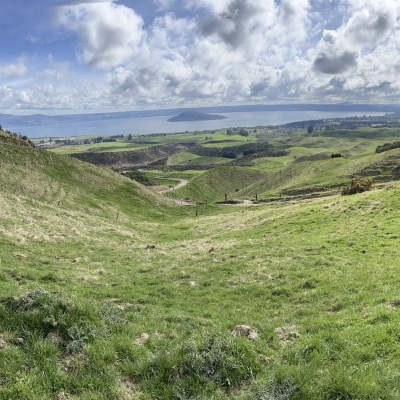
18 September 2024
The view from the top of the Whakpoungakau Lands Trust (WLT) whenua (land) is arguably one of the most scenic in the Lake Rotorua Catchment. Backing on to the Ōkataina Scenic Reserve and sweeping down towards Lake Rotorua, this 800-hectare block holds cultural and economic importance for its people.
Trustee and Chair of WLT, Hariata Ngatai explains that the whenua is a significant part of their identity, so protecting and enhancing it is vital.
“It’s the responsibility of the Trust to look after the land in a way that it can be handed down to the next generation in a better state than we’ve received it.”
It’s a sentiment echoed by Margaret Ransfield, Trustee, and daughter of former trustee John Ransfield.
“As a trustee my job is to maintain the whenua, to look after it so it becomes sustainable in a way that benefits our shareholders. The harvesting of commercial pines planted by my father and previous trustees is one example of balancing economics and the environment. Ultimately, it's about mana whenua, mana kaitiaki, and mana whānau.”
The property is a combination of grazing, pine and mānuka plantations as well as pockets of native bush. Based on its location within the Rotorua catchment, nutrient management rules apply which aim to restore and protect the health of Lake Rotorua. The rules are set to reduce the amount of nutrients, such as nitrogen, entering the lake, halt the degradation, and restore the water quality for future generations to enjoy.
Planted mānuka as part of native re-generation, with Lake Rotorua in background
The collaboration between Toi Moana and WLT to achieve the nutrient targets set for the property is multi-faceted and includes several gorse removal agreements, nitrogen reduction incentives agreements and most recently a comprehensive Environmental Programme.
The implementation of the gorse removal agreement is something that Hariata considers to be a real success for both the environment and the shareholders.
“Five years ago, I used to get calls from our kaumatua about the bright yellow gorse flowers chocking the maunga (mountain). Following the spraying and removal of this invasive, spiky weed thanks to the gorse agreement, I no longer get those calls. It’s also allowed us to clear the land and convert it to mānuka.”
Toi Moana Land Management Team Leader Scott Kusabs explains that gorse is a nitrogen-fixing plant, meaning it extracts nitrogen from the air to help it grow.
“Research shows gorse leaches a huge amount of nitrogen into ground water, which then makes its way to the lake. Too much nitrogen in the lake causes algal blooms to grow, damaging the overall quality of water."
“Gorse is difficult to eradicate and if left unmanaged after clearing will most likely grow back. Seeds can survive for up to 40-80 years before germinating so staying on top of it with control is crucial."
Other components of the recently signed Environmental Programme involve retiring and fencing off pastoral land to plant native trees. The fence has been co-funded by the Trust, Department of Conservation (DOC) and Toi Moana Bay of Plenty Regional Council and has been installed to ensure livestock are excluded from highly erodible land and the neighbouring conservation estate. Native plants will be planted in 6.6 ha of land that is being retired from grazing to help stabilise steep slopes and erodible gullies. Ongoing pest plant and animal control will ensure the native plants will thrive and improve biodiversity values.
The mahi being undertaken on this block is an excellent example of how collaborative work between Toi Moana and a Whakapoungakau Lands Trust can fulfil their goal of caring for the land, the lake, and the people.
For more information on the Rotorua Nutrient Management rules, and options for landowners within the Rotorua Catchment, visit our website and the Rotorua Te Arawa Lakes Programme website.